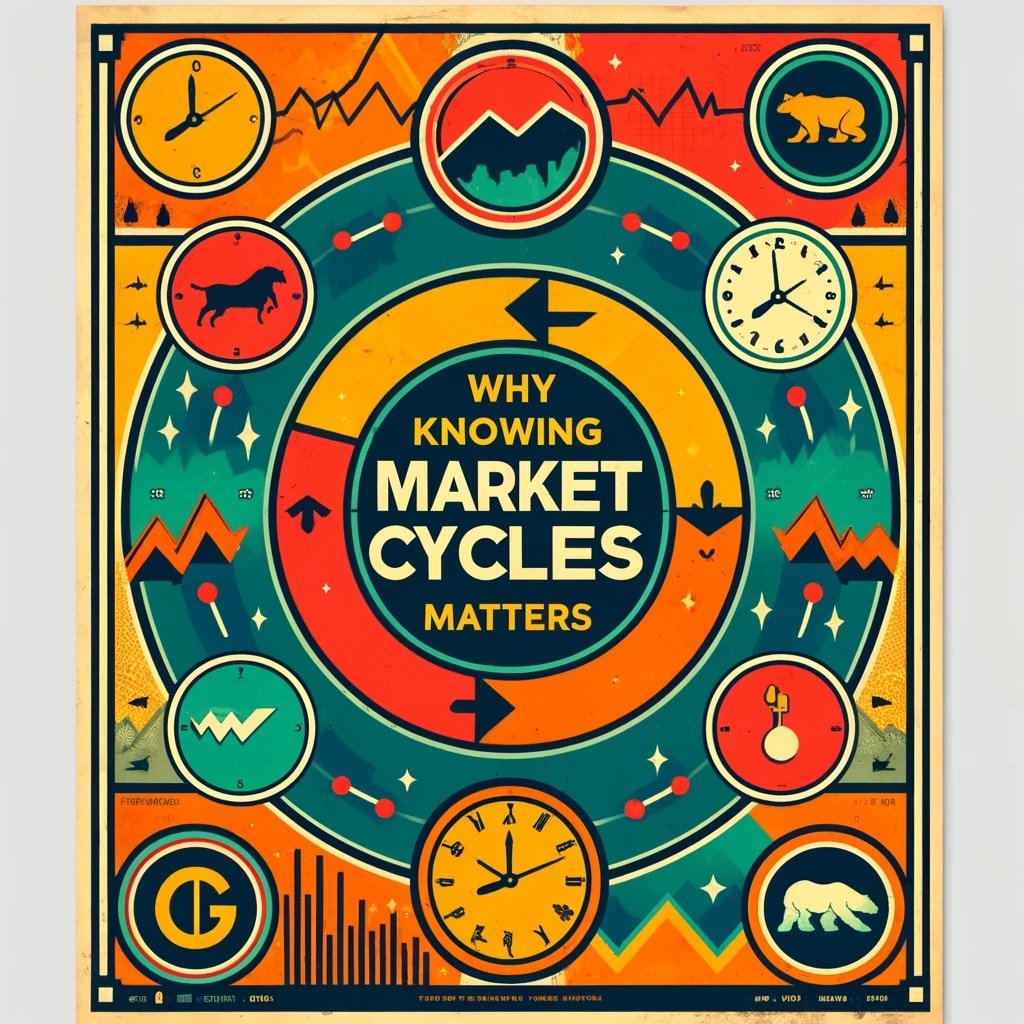When it comes to investing, markets can go in two directions: up or down. A bull market is typically defined as a period of rising prices, where investor optimism is high and growth feels almost unstoppable. In these times, stocks, sectors, and the economy at large appear to be on a constant upward trajectory. Bear markets, on the other hand, are defined by declining prices. Investor confidence tends to fall, and there’s often a wave of cautious sentiment. Market declines can be swift, leaving many investors on edge and some scrambling to protect their portfolios.
source: Financial Wisdom on YouTube
Understanding these two opposing market types is key for any investor looking to maximize returns. It’s not just about knowing when prices are rising or falling; it’s about knowing how to adjust your strategy to fit each cycle. Making gains in a bull market is generally more straightforward, as asset values increase, but the true test of a savvy investor is knowing how to handle—and even profit from—a bear market as well.

Why Knowing Market Cycles Matters
So, why do market cycles matter so much? In short, because no market stays bullish or bearish forever. Both types of markets come with their own opportunities and risks, and missing out on strategies for either could mean missed profits—or worse, significant losses. For example, during a bull market, focusing on growth stocks and high-momentum sectors often yields rewarding returns. In a bear market, defensive moves like investing in bonds, stable assets, or even short-selling can protect, or even grow, an investor’s wealth.
There’s an added benefit to learning how to navigate both markets: confidence. When you understand how to shift your strategies to match the market, it helps reduce fear and emotional decision-making. Knowing you’re equipped for both the highs and lows brings peace of mind and can make you a much more resilient investor.

Introduction to Profiting in Bull and Bear Markets
With the right approach, anyone can learn to profit in both rising and falling markets. Here’s what you’ll find in the following sections:
- Core Strategies for Bull Markets: Discover techniques that capitalize on upward trends, including growth stocks and sector rotation.
- Core Strategies for Bear Markets: Learn how to invest defensively, and explore the role of inverse ETFs and short-selling in down markets.
- Diversification and Asset Allocation: See how adjusting your mix of assets can provide stability and flexibility for any market condition.
- Market Timing and Trend Following: Tips on spotting and acting on market trends, plus methods for staying emotionally balanced during volatile periods.
- Building a Long-Term Strategy for Success: Learn to align short-term strategies with long-term goals for sustainable wealth creation.
Each of these sections is designed to help you make the most of any market, using a balanced approach that fits your investing style. Adapting to market changes isn’t just beneficial—it’s essential for lasting success. By developing an adaptable investment toolkit, you’ll be well-prepared for whatever the market throws your way.
Key Takeaway
To profit in both bull and bear markets, it’s crucial to recognize the nature of each and apply the right strategies. With knowledge, preparation, and an adaptable approach, any investor can build a strategy that weathers the storms and rides the waves. Whether you’re in a roaring bull or a sinking bear, there’s always a way to work the market to your advantage.

Core Strategies for Profiting in Bull Markets
A bull market creates an environment of optimism and rising prices, and it can be a rewarding time for investors who are prepared to harness its momentum. To make the most of a bullish economy, two primary strategies come into play: buying growth and momentum stocks, and rotating into top-performing sectors. Each of these techniques can offer unique opportunities for strong returns when the market is on the upswing. Let’s explore how these strategies work and how you can use them effectively.
Buying Growth and Momentum Stocks
One of the most popular strategies in a bull market is to invest in high-growth stocks. These are companies expected to grow at an above-average rate compared to others in the market. Think of tech giants, innovative biotech firms, or fast-scaling consumer brands. In a rising market, these stocks not only gain from general investor optimism but often also experience price increases due to their potential for long-term growth.
Growth stocks are attractive because they’re focused on reinvestment, aiming for expansion rather than simply delivering dividends. Their approach can lead to high valuations, but in a bull market, investors are more willing to take on the associated risks due to the potential for significant rewards. It’s also important to understand the idea of momentum investing: this approach capitalizes on stocks that have already shown strong upward trends. In a bullish environment, these stocks tend to keep moving in the same direction as long as demand remains high.
To get started with growth and momentum investing, consider the following tips:
- Look for High Earnings Growth: Companies with a history of growing revenues and profits year after year often outperform in bull markets.
- Identify Positive Market Sentiment: Follow stocks that are already gaining traction with investors; these often have the momentum to keep climbing.
- Monitor Price Trends: Using technical indicators like moving averages can help you spot whether a stock is in a strong uptrend or just starting to gain momentum.

Sector Rotation for Bull Markets
Sector rotation is another powerful tool in a bull market. Not all sectors perform equally, and in bullish periods, certain areas tend to lead the way. For instance, technology, consumer discretionary, and financials often thrive as consumer confidence rises and economic growth supports increased spending. By rotating into sectors expected to outperform, investors can focus on high-potential areas rather than sticking to a broader index.
Sector rotation involves shifting investment focus as different industries gain favor. The idea is to buy into sectors likely to benefit the most from current economic trends, and in a bull market, that often means looking toward sectors that excel with increased consumer and business spending.
Some key tips for sector rotation include:
- Follow Economic Indicators: Sectors like financials and consumer discretionary tend to perform well when interest rates are stable or low, so keep an eye on policy changes and economic reports.
- Use Sector-Specific ETFs: Exchange-traded funds (ETFs) focused on specific sectors can make it easier to invest in a targeted area without needing to pick individual stocks.
- Look for Cyclical Sectors: Sectors tied to economic cycles, like technology or industrials, often benefit during growth phases and may be worth prioritizing.
Timing Your Moves
The timing of these strategies is crucial. In a bull market, growth and momentum stocks can sometimes experience sharp rises, so it’s essential to stay updated on market news and trends. With sector rotation, entering a sector too early or too late can mean missed opportunities or minimized gains. Utilizing financial news, economic forecasts, and market data can help in making well-timed decisions.

Core Strategies for Profiting in Bear Markets
In a bear market, when prices are falling, the strategies that thrive in bullish conditions often become ineffective. To navigate these downturns, savvy investors shift focus to defensive stocks, safe-haven assets, and strategic options like short selling and inverse ETFs. Each approach has its own risks and rewards, and understanding them can help you make informed decisions that protect and even grow your portfolio in a challenging market.
Defensive Stocks and Safe Havens
When the market is tumbling, defensive stocks provide a level of resilience. Sectors like utilities, healthcare, and consumer staples are known for their stability in economic downturns because they provide essential goods and services that consumers rely on regardless of market conditions. Utilities, for example, provide energy and water—necessities people pay for even in tough times. Similarly, healthcare and consumer staples remain in demand as they cover essential products and services.
Investing in these sectors can provide stability because their earnings and revenue streams are less susceptible to market volatility. While they may not offer the high returns seen in a bull market, they often outpace other sectors when the economy dips.
In addition to defensive stocks, safe-haven assets like gold and treasury bonds offer additional protection. Gold has traditionally been viewed as a store of value, often moving inversely to stock prices. When the market declines, gold prices frequently rise, offering investors a hedge against losses. Treasury bonds, particularly U.S. Treasuries, are another safe haven, as they’re backed by the government and are considered among the safest investments. Bonds pay out regular interest and typically hold value better than equities in times of economic stress.
Here are some tips for defensive and safe-haven investing in a bear market:
- Choose Utility and Healthcare Stocks: These sectors provide stability due to consistent demand.
- Add Gold to Your Portfolio: Gold can hedge against stock market declines and currency depreciation.
- Consider Treasury Bonds: Bonds offer income and stability when stocks are volatile.

Short Selling and Inverse ETFs
For investors looking to actively profit from falling markets, short selling and inverse ETFs are two strategies that can deliver gains as stock prices drop. Short selling involves borrowing shares to sell them at the current price, with the intent to repurchase them later at a lower price, thereby profiting from the difference. This strategy allows you to earn money as the stock declines. However, it comes with high risk: if the stock price rises instead, potential losses are theoretically unlimited, as there’s no cap on how high a stock price can go.
Inverse ETFs offer a way to benefit from a market drop without the complexity of short selling. Inverse ETFs are designed to move in the opposite direction of a particular index or sector. For example, an inverse S&P 500 ETF would increase in value when the S&P 500 declines. This tool is especially useful for bear markets, as it allows investors to hedge or profit from downturns with the ease of trading regular ETFs. However, these funds are typically reset daily, meaning their performance can deviate from the expected inverse relationship over longer periods.
Here are some key points to consider when using these strategies:
- Short Selling Requires Skill: It’s a complex technique best suited for experienced investors.
- Inverse ETFs Simplify Bear Market Profits: They provide downside exposure without the risks tied to short selling.
- Know the Risks: Both short selling and inverse ETFs can lead to significant losses if the market moves unexpectedly.

Diversification and Asset Allocation
In both bull and bear markets, a well-diversified portfolio is like a safety net. Diversification across various asset classes—such as stocks, bonds, and commodities—spreads risk and lessens the impact of volatility on your investments. By not placing all your eggs in one basket, you protect your capital from the sharp declines that can occur when markets take unexpected turns. This section delves into the power of diversification and the role of dynamic asset allocation in achieving balance and stability.
The Importance of Diversification in All Markets
Diversification is about managing risk through variety. When you allocate funds across different asset classes, you reduce the likelihood of severe losses because the assets don’t all respond the same way to market shifts. For example, when stocks fall, bonds might remain stable or even rise, offering a buffer against the stock market’s ups and downs.
During bear markets, diversification becomes particularly valuable. Stocks may plummet, but other assets, like bonds or commodities, often maintain value or appreciate. By balancing investments in various asset classes, investors avoid the full brunt of a downturn and preserve capital to take advantage of recovery phases. In bull markets, diversification provides exposure to high-growth opportunities while keeping part of the portfolio anchored in less volatile assets.
Some key diversification strategies include:
- Mix Stocks with Bonds: Equities provide growth, while bonds offer stability, especially in uncertain times.
- Add Commodities for Inflation Hedge: Commodities like gold can protect against inflation and stock market dips.
- Consider Global Investments: Including international assets broadens exposure and minimizes region-specific risks.

Dynamic Asset Allocation
Static asset allocation is useful but might not always maximize returns or minimize risks. Dynamic asset allocation introduces flexibility by adjusting your investments according to market conditions. When the economy is booming, you might shift more toward equities. In times of uncertainty, however, it could be wise to increase holdings in bonds or alternative assets that typically fare well in downturns.
For example, suppose you hold a traditional 60/40 portfolio split between stocks and bonds. In a prolonged bull market, you might adjust to 70% stocks and 30% bonds to capture more upside from equities. Conversely, if recession warnings loom, reducing equity exposure and increasing bond holdings or cash equivalents can reduce risk.
Here are some ways to incorporate dynamic allocation:
- Rebalance Regularly: Periodic adjustments, often quarterly or yearly, help maintain your target allocation and respond to market changes.
- Respond to Economic Cycles: Shift between equities and bonds based on economic indicators like interest rates and inflation.
- Add Alternative Assets: In volatile times, assets like real estate, commodities, or private equity can add stability and diversify beyond stocks and bonds.
Achieving Balance in Your Portfolio
The combination of diversification and dynamic asset allocation creates a balanced portfolio capable of withstanding market fluctuations. A portfolio balanced between growth and defensive assets provides the dual benefits of capital appreciation and protection. By spreading investments across diverse asset classes and staying adaptable, investors can face both bull and bear markets confidently.
Key Takeaways:
- Diversification Reduces Risk: A diversified portfolio with stocks, bonds, and commodities shields against sharp downturns.
- Dynamic Allocation Responds to Change: Adjusting allocations based on economic shifts optimizes performance and mitigates losses.
- Balance for Resilience: Blending various assets and adjusting as needed helps achieve growth while preserving stability.
By maintaining a diversified and adaptable portfolio, you position yourself to capitalize on growth and protect against downturns.

Market Timing and Trend Following
Mastering market timing and trend following can give investors an edge. Spotting trends early and knowing when to buy or sell can enhance returns, but it requires a disciplined approach. This section explores how to identify market trends effectively and avoid emotional reactions during volatile periods.
Identifying Market Trends
Market trends are powerful indicators that reveal the general direction of asset prices over time. Recognizing these trends can help you anticipate shifts, making it possible to enter or exit positions at the right moments. By studying patterns and analyzing data, investors can make more informed choices rather than relying on guesswork.
Technical analysis tools are commonly used to identify trends. Some of the most effective include:
- Moving Averages: This indicator smooths out price data to show the direction of a trend. A 50-day moving average, for example, offers a snapshot of recent price direction, while a 200-day moving average shows long-term trends. When the shorter moving average crosses above the longer one, it’s often a buy signal; crossing below can be a signal to sell.
- Relative Strength Index (RSI): RSI measures the momentum of a stock, indicating whether it’s overbought or oversold. RSI values range from 0 to 100, with levels above 70 considered overbought and below 30 oversold. By keeping an eye on RSI, investors can spot potential turning points.
- MACD (Moving Average Convergence Divergence): MACD helps reveal shifts in momentum by plotting the relationship between two moving averages. When the MACD line crosses above the signal line, it’s often a buy signal; a crossover below can be a sell signal.
By combining these tools, investors can better gauge when to ride the trend or exit before reversals.

Avoiding Emotional Investing
One of the biggest threats to investment success is emotional decision-making. Markets fluctuate, and fear or greed can easily lead investors to make hasty moves. Having a strategy that relies on data, rather than emotions, is essential for consistent gains.
Setting clear entry and exit points is a powerful way to avoid impulsive decisions. Knowing in advance at what price you’ll buy or sell a stock, regardless of temporary market hype, keeps you grounded. For example, using “stop-loss” orders can help investors exit when a stock dips to a predetermined price, protecting against severe losses.
Here are some tips for staying disciplined:
- Create a Trading Plan: Outline your goals, target prices, and exit strategies. Stick to this plan, especially during times of high market volatility.
- Use Automated Orders: Tools like stop-loss and limit orders remove the pressure of manually tracking prices. This way, your investments follow the plan regardless of daily fluctuations.
- Monitor Market Indicators, Not Market Hype: Focus on reliable indicators, like the moving averages and RSI, rather than news headlines that often fuel short-term panic.
Staying Focused Through Volatility
Market timing can be stressful, especially when prices fluctuate. But by grounding your decisions in data and following a clear plan, you’ll avoid the common traps of panic selling or impulsive buying. Investors who can maintain focus tend to fare better in the long run. Being prepared to sit through market noise, while keeping an eye on reliable indicators, sets the stage for consistent, long-term success.
Key Takeaways:
- Use Indicators to Track Trends: Moving averages, RSI, and MACD help highlight entry and exit opportunities.
- Stick to Data, Not Emotions: A clear strategy reduces the likelihood of reactive decisions during volatile periods.
- Plan Ahead: Set specific entry and exit points to maintain discipline and avoid emotional pitfalls.
Trend following and disciplined market timing go hand in hand. By combining both, investors can strengthen their portfolios, catching upward trends while sidestepping the emotional pitfalls that trip up many others.

Building a Long-Term Strategy for Success
A successful investing strategy requires balancing immediate opportunities with a long-term vision. Investors who aim for both short-term gains and sustained growth often achieve the most consistent success. Here, we explore ways to structure your investments to capture gains while building lasting wealth.
Balancing Short-Term Gains and Long-Term Growth
Short-term gains can provide quick profits, but they shouldn’t derail your path to long-term wealth creation. By setting a solid foundation with longer-term investments, you’ll build resilience into your portfolio, allowing you to weather market ups and downs. The key is not putting all your efforts into short-term moves but rather creating a blend of high-potential investments for growth and stable assets that mature over time.
Long-term investing prioritizes assets with strong growth potential, like blue-chip stocks or diversified index funds. These assets appreciate steadily, offering compounded returns over the years. Shorter-term opportunities, on the other hand, might include higher-volatility sectors or timing certain trades based on market momentum.
Balancing the two can look like this:
- Maintain a Core Portfolio: Dedicate the bulk of your investments to assets that align with long-term goals, ensuring stability.
- Allocate a Portion for Short-Term Plays: Use a smaller portion for growth stocks or sectors with immediate potential, but set limits to avoid overexposure.
- Reassess Periodically: Markets shift, and so might your goals. Regularly evaluate if your current mix aligns with your ultimate financial objectives.
Setting Long-Term Goals
Having a vision for the future is essential for creating a resilient strategy. Without clear goals, it’s easy to chase temporary gains at the expense of sustained growth. Start by defining what you want to achieve—whether it’s retirement savings, building wealth for your family, or achieving financial independence. Once these goals are clear, align your portfolio with strategies that fit each one.
Here are a few points to consider:
- Be Specific: Set clear, measurable goals for different time frames.
- Adapt as Necessary: Markets and personal circumstances change. Be ready to adjust your approach without losing sight of your main objectives.
- Prioritize Risk Management: In pursuit of long-term goals, minimizing unnecessary risk is essential. Consider strategies like diversification and regular portfolio reviews.
Final Tips and Key Takeaways
In both bull and bear markets, a flexible, well-informed approach allows you to capture opportunities while protecting against losses. Here are some key strategies for success in any market:
- Stay Flexible: Flexibility helps you respond to new opportunities or potential downturns.
- Manage Risk Diligently: Effective risk management is the backbone of long-term investing success.
- Commit to Ongoing Education: Markets change, and keeping up with trends and techniques keeps your strategy relevant.
Consider the following as core principles:
- Diversify Across Asset Classes: Avoid putting all your eggs in one basket by investing in a mix of stocks, bonds, real estate, and other assets.
- Maintain a Long-Term Mindset: Don’t let short-term losses or market corrections push you off course.
- Stay Disciplined with Entry and Exit Points: When the market shifts, knowing when to step in—or out—protects your gains and minimizes losses.

Building for the Future
Investing is a journey. Building a balanced strategy that includes both short-term opportunities and long-term goals positions you for consistent success. Keep a clear vision, adapt as needed, and prioritize informed decision-making. Over time, these practices will build a resilient portfolio that thrives in any market condition, helping you reach your financial aspirations with confidence.
Top Secrets to Profiting in Bull and Bear Markets: 12-Question FAQ (Key Strategies for Any Cycle)
How do bull and bear markets differ—and why does it matter for strategy?
Bull markets reward growth, momentum, and risk-on positioning; bear markets reward defense, hedging, and capital preservation. Knowing which regime you’re in helps you pick the right playbook, size positions appropriately, and set realistic return/risk expectations.
What simple, repeatable strategy works well in bull markets?
“Buy the leaders on pullbacks.” Focus on fundamentally strong names or sector/market ETFs making higher highs. Enter on pullbacks to rising moving averages or prior breakout levels, with stops just beyond invalidation; take partial profits into strength.
How can I use sector rotation to enhance returns in a bull?
Follow economic proxies (rates, credit, PMIs) and relative strength to tilt toward pro-cyclical sectors (tech, discretionary, industrials) early/mid-cycle and quality/financials late-cycle. Use liquid sector ETFs for clean, diversified exposure and rebalance on schedule.
What’s a core defensive playbook for bear markets?
Favor resilience and ballast: high-quality/low-volatility equities, staples, utilities, healthcare, investment-grade bonds, and cash. Pair with hedges (index puts, collars) or limited-risk short exposure (put spreads, inverse ETFs in modest size).
How do I profit from downtrends without blowing up?
Keep shorts and inverse ETFs sized small, time-boxed, and rules-based. Prefer defined-risk options (put debit spreads) over naked shorts. Target clear breakdowns/failed rallies and predefine exits; avoid fighting violent bear-market rallies.
What role does diversification play across cycles?
It’s your drawdown dampener. Blend return engines (equities), shock absorbers (bonds, cash), and diversifiers (gold/commodities/alternatives). True diversification is about independent risk, not just more line items—watch correlations, not tickers.
Should I change my asset mix as the cycle evolves?
Yes—use dynamic (or at least rules-based) allocation. Raise risk exposure as uptrends strengthen and breadth broadens; reduce equity beta and add ballast when macro and trend signals deteriorate. Rebalance on a fixed cadence, with tolerance bands.
How can trend following help in both bulls and bears?
A simple price-based rule (e.g., 200-day MA or multi-month breakout/breakdown) keeps you aligned with the primary move and cuts big losers early. Combine with a shorter confirmation (e.g., 50-day) for faster exits and re-entries, but keep rules consistent.
What are practical hedging tactics for everyday investors?
Index put spreads dated 1–3 months; 2) Partial collars on concentrated positions; 3) Small sleeves of inverse index ETFs during event risk. Size hedges to cushion portfolio drawdowns (not to eliminate them) and budget the premium like insurance.
How do I avoid emotional mistakes in volatile markets?
Pre-commit: write entries, exits, and sizing before the trade; use stop/limit orders; cap daily/weekly loss; review weekly with a journal. Turn down noise—follow data (breadth, trends, credit) rather than headlines.
How should I balance short-term tactics with long-term goals?
Build a “core-satellite” plan: keep 70–90% in long-term, tax-efficient core (broad equity/bond/alt mix), and 10–30% for tactical tilts (sectors, factors, hedges). The core compounds; the satellite adapts to the cycle.
What one-page checklist can I use before placing a trade?
Thesis (why now?), Trend (up/down/range?), Level (entry/stop/target), Risk (max % and $), R:R (≥1:2?), Correlation (already long/short similar risk?), Catalyst (macro/earnings?), Exit rules (profit/invalid), and Position size (based on stop distance).
Important Information
Comprehensive Investment Disclaimer:
All content provided on this website (including but not limited to portfolio ideas, fund analyses, investment strategies, commentary on market conditions, and discussions regarding leverage) is strictly for educational, informational, and illustrative purposes only. The information does not constitute financial, investment, tax, accounting, or legal advice. Opinions, strategies, and ideas presented herein represent personal perspectives, are based on independent research and publicly available information, and do not necessarily reflect the views or official positions of any third-party organizations, institutions, or affiliates.
Investing in financial markets inherently carries substantial risks, including but not limited to market volatility, economic uncertainties, geopolitical developments, and liquidity risks. You must be fully aware that there is always the potential for partial or total loss of your principal investment. Additionally, the use of leverage or leveraged financial products significantly increases risk exposure by amplifying both potential gains and potential losses, and thus is not appropriate or advisable for all investors. Using leverage may result in losing more than your initial invested capital, incurring margin calls, experiencing substantial interest costs, or suffering severe financial distress.
Past performance indicators, including historical data, backtesting results, and hypothetical scenarios, should never be viewed as guarantees or reliable predictions of future performance. Any examples provided are purely hypothetical and intended only for illustration purposes. Performance benchmarks, such as market indexes mentioned on this site, are theoretical and are not directly investable. While diligent efforts are made to provide accurate and current information, “Picture Perfect Portfolios” does not warrant, represent, or guarantee the accuracy, completeness, or timeliness of any information provided. Errors, inaccuracies, or outdated information may exist.
Users of this website are strongly encouraged to independently verify all information, conduct comprehensive research and due diligence, and engage with qualified financial, investment, tax, or legal professionals before making any investment or financial decisions. The responsibility for making informed investment decisions rests entirely with the individual. “Picture Perfect Portfolios” explicitly disclaims all liability for any direct, indirect, incidental, special, consequential, or other losses or damages incurred, financial or otherwise, arising out of reliance upon, or use of, any content or information presented on this website.
By accessing, reading, and utilizing the content on this website, you expressly acknowledge, understand, accept, and agree to abide by these terms and conditions. Please consult the full and detailed disclaimer available elsewhere on this website for further clarification and additional important disclosures. Read the complete disclaimer here.




